Day 3 of a long weekend of Autumn Migration tours today, our final day. With rain forecast for the morning, and having bagged most of the best birds along the coast in the last couple of days, we decided to head for Titchwell where we could get some shelter in the hides.
A couple of Dotterel were belatedly reported from Choseley yesterday. We had no idea if the report was genuine, but we diverted round that way for a brief look first, just in case. Not surprisingly, there was no sign of any Dotterel in the fields, but a little group of five Golden Plover flew over calling, as did a Yellowhammer. At that stage the rain started, so we headed down to Titchwell.
The car par was already surprisingly busy when we arrived, and we couldn’t find any spaces in the first section. There didn’t seem to be much activity in the bushes around the overflow car park – most of the birds were probably sheltering from the wind and rain – so we headed straight out towards the reserve. At first the feeders by the visitor centre appeared quiet, but something spooked a load of finches from the ground behind and they flew up into the trees. In with them, we found a couple of Brambling and one helpfully then dropped down onto one of the feeders where we could get a better look at it.
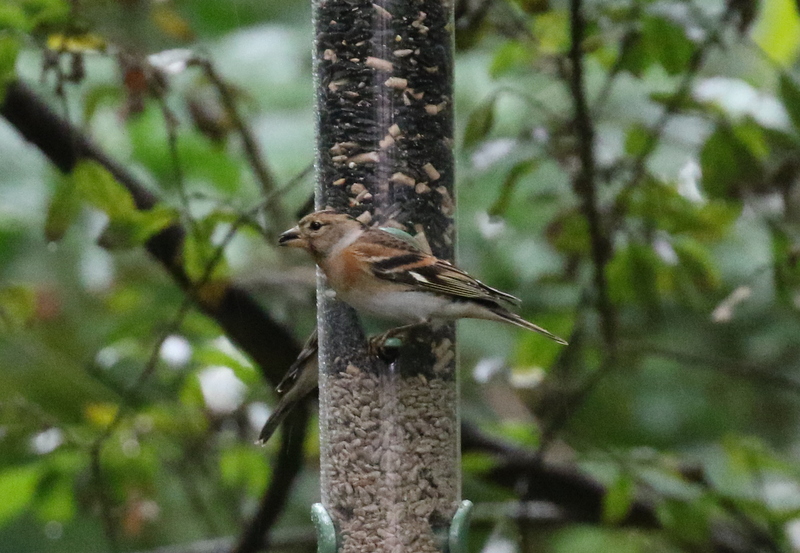 Brambling – two were on the feeders by the visitor centre first thing
Brambling – two were on the feeders by the visitor centre first thing
Given the rain, we decided to head straight out to the shelter of Island Hide. It proved to be a wise move, as the rain got stronger for a time while we were in there. We did have a quick look at the grazing meadow ‘pool’ on the way, which was once again pretty empty, and the reedbed pool which held just a few Gadwall and a couple of Coot today.
There were lots of birds out on the freshmarsh, particularly large numbers of duck now – mainly Teal and Wigeon, plus smaller numbers of Shoveler and Gadwall, and a few Shelduck. Some of the drakes are now starting to emerge from drab eclipse plumage, & looking correspondingly smarter.
 Teal – starting to emerge from eclipse plumage now
Teal – starting to emerge from eclipse plumage now
There was a good selection of waders too, and while we waited for the rain to ease we set about looking through them. Most of the larger waders were in the deeper water over towards the back, a good number of Black-tailed Godwits and about 15 Avocets still (most of the Avocets have now gone south for the winter). On the mud at the edge of the reeds, the Ruff had presumably found some shelter from the wind. A party of three Greenshanks stood with them calling for a while, before they flew off west.
Looking around the various islands,we could see several Golden Plover and Lapwing in the grass. A few Dunlin and Ringed Plover were running around in amongst them too. Then we found a Little Stint – it was hard to see at first, being so small in the taller vegetation, but we all eventually got a good look at it when it came out onto a small pool. A Jack Snipe on the nearest island came out into the open for a time, where we could see it bobbing up and down continuously as it walked along slowly feeding, before disappearing into the vegetation again.
By this stage the rain had eased, so we decided to walk round to Parrinder Hide. As we got round to the junction in the path, we had a quick look over the bank at Volunteer Marsh, which was rewarded with a nice close Curlew Sandpiper and two nearby Dunlin. We watched the Curlew Sandpiper for a while as it fed on the mud just the other side of the channel, before it walked into the water and started bathing, giving us a great view of its white rump in the process. Then it flew off further back and we headed for the hide.
 Curlew Sandpiper – this juvenile gave great views on the Volunteer Marsh
Curlew Sandpiper – this juvenile gave great views on the Volunteer Marsh
From round at the Parrinder Hide, you get a different view of the freshmarsh. At first, we saw many of the same birds that we had seen from the other side, but then one of the group picked up a different Curlew Sandpiper on one of the islands, another juvenile but this one much paler, lacking any orangey wash on the breast now and already moulting some of its upperparts to grey first winter feathers. We also found a second Little Stint, a much duller individual than the first. Three Spoonbills were asleep over the back of the fresmarsh, until two decided to wake up and fly off over the bank.
A Jack Snipe appeared on the edge of the mud directly opposite the hide, much closer than the one we had seen earlier, giving us great views as it crept in and out of the vegetation. We could see the golden yellow back strips contrasting with the otherwise very dark upperparts, and the dark central crown strip. This was presumably our second of the day, as it was in a very different place to the first, and there have been at least two Jack Snipe at Titchwell recently.
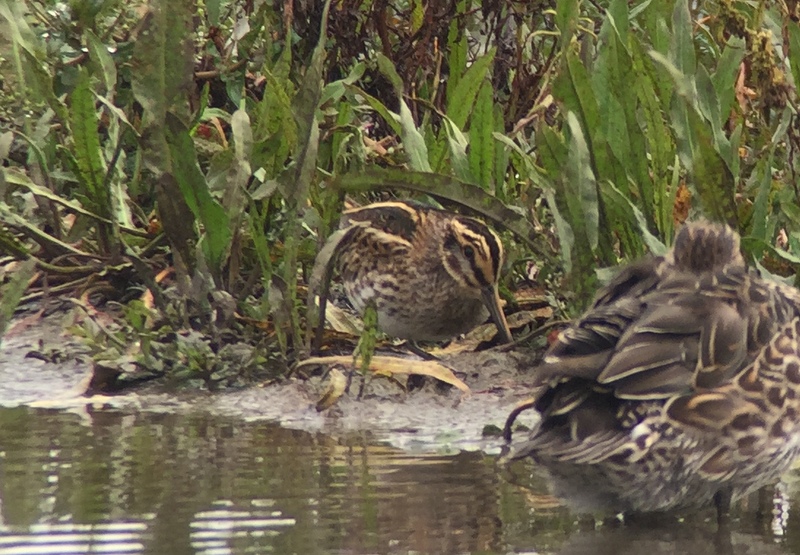 Jack Snipe – showed very well in front of Parrinder Hide
Jack Snipe – showed very well in front of Parrinder Hide
There were lots of Meadow Pipits on the grass in front of Parrinder Hide and we had been looking for a Rock Pipit in with them. While everyone was looking at the Jack Snipe, a sharp call alerted us to an incoming pipit but it didn’t sound strident enough for a Rock and we looked across to see a very smart Water Pipit drop in, the first we have seen here this autumn. With very white underparts with black streaks, a well marked white supercilium and white wing bars, and the greyish head and neck contrasting with the browner mantle, it is a very different bird to the more swarthy Rock Pipits.
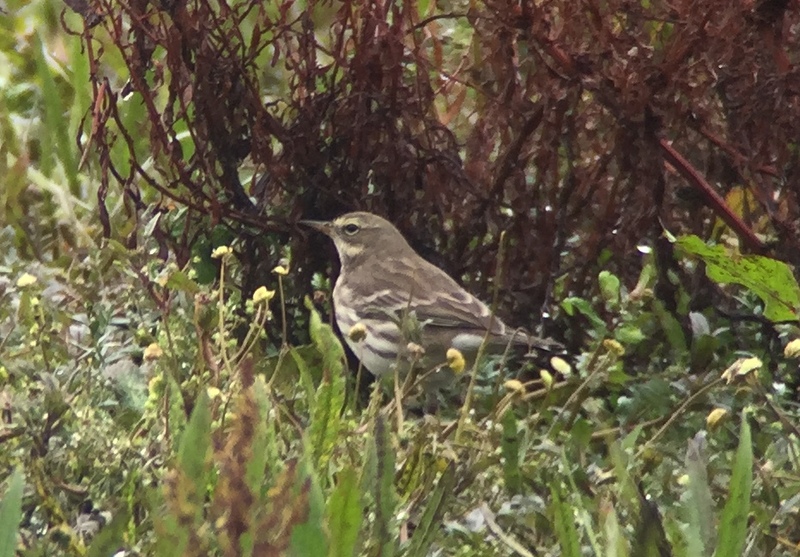 Water Pipit – the first we have seen at Titchwell this autumn
Water Pipit – the first we have seen at Titchwell this autumn
Between the Jack Snipe and the Water Pipit, we didn’t know which way to look. Then both worked their way round so they were together, saving us that decision!
 Water Pipit & Jack Snipe – together, in the same scope view
Water Pipit & Jack Snipe – together, in the same scope view
For once the forecast was right and the rain stopped. It hadn’t even hindered our ability to see a great variety of birds! We had a quick look at the Volunteer Marsh from the other side of Parrinder Hide. We had very nice views of a close Grey Plover, and what was presumably the same Curlew Sandpiper we had seen earlier from the path was now in front of the hide.
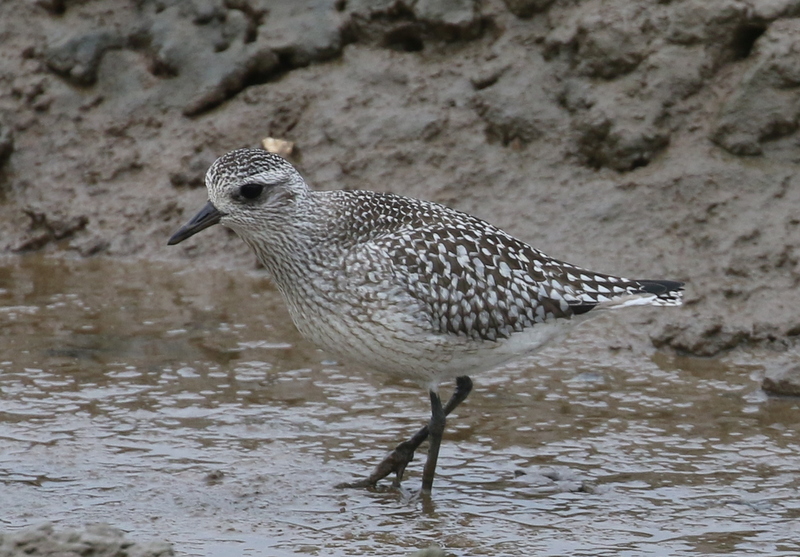 Grey Plover – nice views on the Volunteer Marsh from Parrinder Hide
Grey Plover – nice views on the Volunteer Marsh from Parrinder Hide
With the improvement in the weather, we decided to make our way out towards the beach. On the other side of the Volunteer Marsh, along the near edge of the channel next to the main path, we had a nice close Black-tailed Godwit. Just across the channel on the other side, a Turnstone (or perhaps a ‘Turn-mud’) was turning over the dried and cracked plates of mud looking for invertebrates. Perhaps this was the same bird we had seen doing exactly the same thing here three weeks ago?
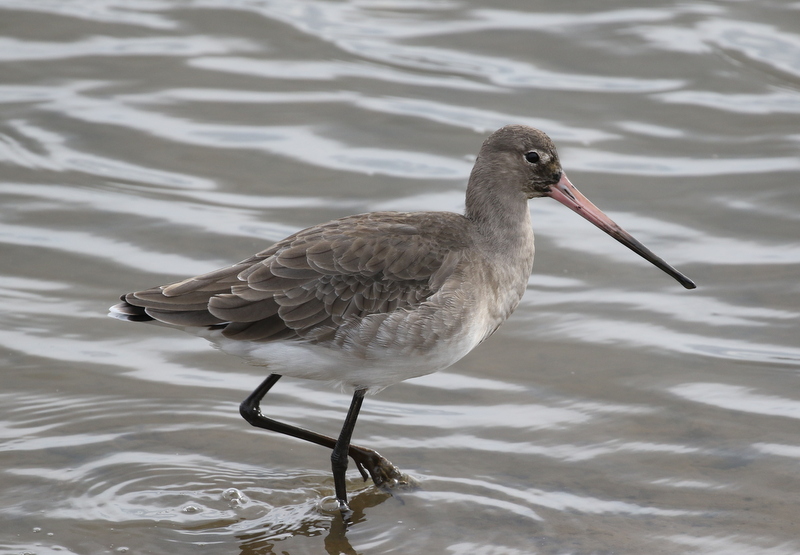 Black-tailed Godwit – right by the main path on the Volunteer Marsh
Black-tailed Godwit – right by the main path on the Volunteer Marsh
The Tidal Pools added a few Little Grebes for the day’s list and a flock of Starlings which flew across from there to the saltmarsh included the striking all-white leucistic bird which has been hanging around the area for some weeks now. Out at the beach the tide was out, so the waders were all down feeding on the mussel beds. As well as lots of Oystercatchers, we could see a good number of Bar-tailed Godwits and Knot. A few Sanderling were running in and out of the waves down on the edge of the beach but another came and landed right in front of us on the sand briefly.
We walked halfway down the beach to the comparative shelter of the concrete blocks, giving us a bit of protection from the brisk southerly breeze, and started to scan the sea. A nice close Velvet Scoter was the main prize, diving for shellfish just offshore. There were lots of Common Scoter way off in the distance towards the Wash but one drifted closer in just behind the Velvet Scoter giving us a much better view. There were also several Great Crested Grebes out on the sea closer inshore, but a couple of Red-throated Divers were much further out and hard to get onto given the choppy water. Two Red-breasted Mergansers and a couple of Gannets flew west.
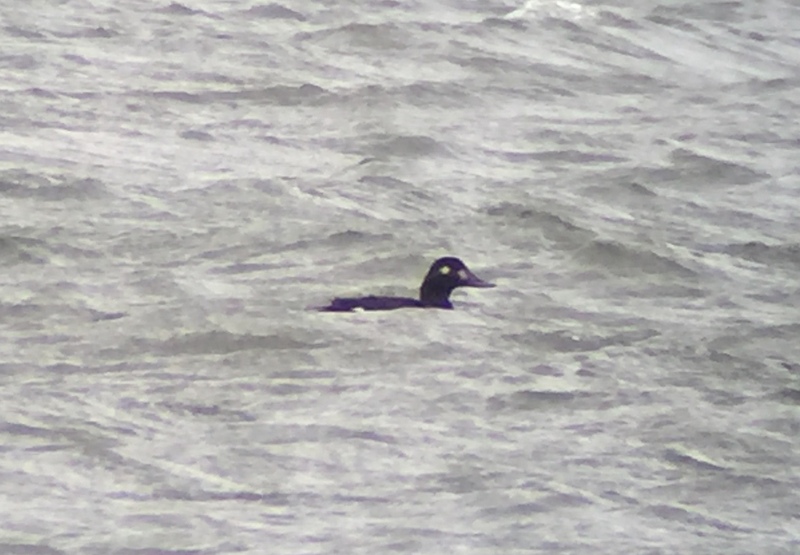 Velvet Scoter – diving for shellfish offshore
Velvet Scoter – diving for shellfish offshore
The other highlight out at the beach was watching lots of different birds coming in over the sea, presumably fresh from the continent, migration in action! Several small groups of Brent Geese flew in and a few landed on the beach. Flocks of Chaffinches, Starlings and thrushes all got to dry land safely. An exhausted Fieldfare just made it to the mussel beds and crashed down out of view, but was promptly chased off by several of the waders and was forced to rest out in the open on the beach. We picked up a Grey Heron coming in, some way out to see initially. It eventually flew in over the beach and dropped down onto the tidal pools.
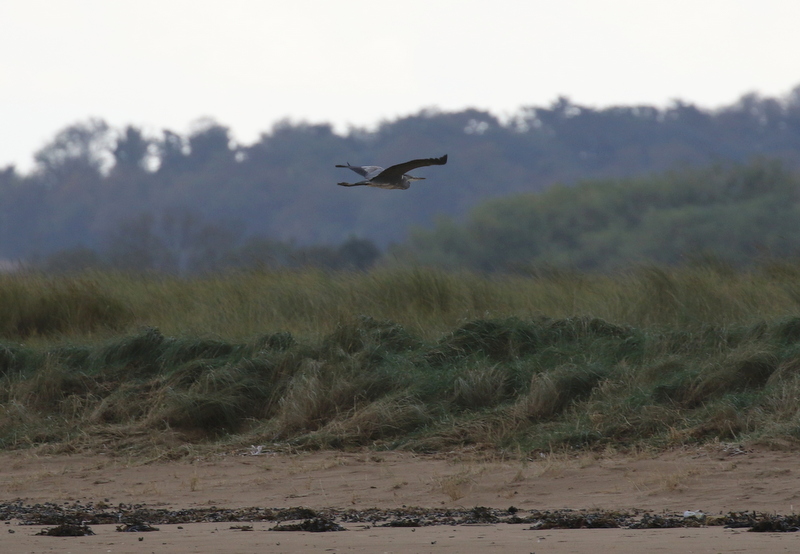 Grey Heron – flew in from the sea and over the beach
Grey Heron – flew in from the sea and over the beach
Despite the early rain, it had been an action packed morning but it was now time to start heading back for lunch. We walked back round via the Meadow Trail, and not far in from the main path we heard a Yellow-browed Warbler calling from deep in the sallows. It was a bit windy here today and we had all enjoyed good views of Yellow-browed Warbler already in the last couple of days, so we didn’t linger.
Back at the visitor centre, a couple of birders told us that a White-fronted Goose had been seen in the cut maize field by the reserve entrance road, so we made a short detour to see that. It was feeding on its own by a small pool out in the field, so we had a nice look at it through the scope, an adult with white blaze around the bill and black belly bars.
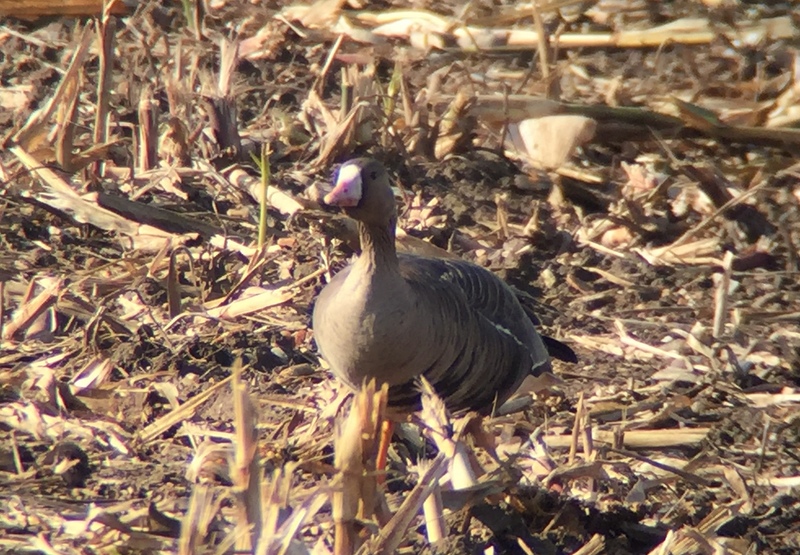 White-fronted Goose – in the field by the reserve entrance road
White-fronted Goose – in the field by the reserve entrance road
We had lunch in the sunshine in the car park today. While we were eating, we heard a Yellow-browed Warbler calling on the sunny edge of the sallows at the far end. Most of the group decided to focus on refuelling, but for those that didn’t we had brief views of the Yellow-browed Warbler flitting around in the trees.
News had come through during the morning that a Cattle Egret had been seen coming in off the sea at Cley and it had later been located with the cows out on Blakeney Freshes. As it would be a new bird for several of the group, we decided to drive back that way and try to see it in the afternoon. When we got to Blakeney, we parked by the harbour and walked round towards Friary Hills which is a good vantage point from which to scan. We had just got past the duck pond when a couple coming back the other way told us that they had just watched the Cattle Egret fly off towards Cley, where they had lost it to view.
Back to the car, we climbed in again and drove round towards Cley, pulling up briefly at the entrance to Friary Hills to confirm the news of the Cattle Egret‘s departure with a couple local birders. From the West Bank at Cley, it was immediately apparent there were no cows left out on the marshes, they had all been taken in for the winter already. Cricket Marsh did at least provide Canada Goose and Rook as additions to the weekend list, so perhaps he journey wasn’t entirely wasted!
Climbing up onto the West Bank by the main sluice to scan the marshes, we happened to look back towards Blakeney where we could see some cows out in the distance over on the Freshes. Just at that moment, we a saw small egret fly up from with them and head off away from us back to where the Cattle Egret had originally been seen. Back in the car and we drove back round to Friary Hills.
When we got up onto the top we were told that the Cattle Egret had indeed reappeared with the cows here, but had been flushed by a Marsh Harrier and had flown up from the nearest herd and dropped back out of view behind the reeds with a more distant group. Thankfully it then flew out and joined the cows and we watched it for some time, walking about, in with cows at times but also stalking around on its own in the low lying boggy areas of the marsh.
 Cattle Egret – in with the cows
Cattle Egret – in with the cows
We had a good look at the Cattle Egret through the scope – we could see its short yellow-orange bill and small size, with scale being provided by a Grey Heron which was close to it at one point. It was always a little distant and never came back to the closer group of cows while we were there. We did talk about walking out along the bank around the Freshes to get a closer look, but there was little enthusiasm for the walk and it was lovely standing up on Friary Hills in the afternoon sun, scanning the marshes and watching the Cattle Egret with the cows.
There were other birds to see here too. A Green Sandpiper flew around over the marshes a couple of times and a Common Snipe or two did the same. There were lots of Wigeon down on the grazing marshes below us, and a huge cloud flew in to join them when they were flushed from the eastern part of the Freshes by a group of walkers. In with them, we could see a few Teal and a single Pintail.
Several species of raptor were enjoying the sunshine. A couple of Common Buzzards perched on some fenceposts, preening, before flying round and hovering out over the grass. Several Marsh Harriers quartered back and forth over the reeds, unfortunately never quite getting close enough to the Cattle Egret to flush it back towards us. A Sparrowhawk flew in from hunting out over the marshes and disappeared over the trees behind us.
There were still a few migrants to see from here too. Several little flocks of thrushes, particularly Redwings, flew overhead. Two Fieldfares were feeding down in the grass with a flock of Starlings. It was a lovely way to end what had been a very exciting three days of birding, with some very good birds seen and great company.
















